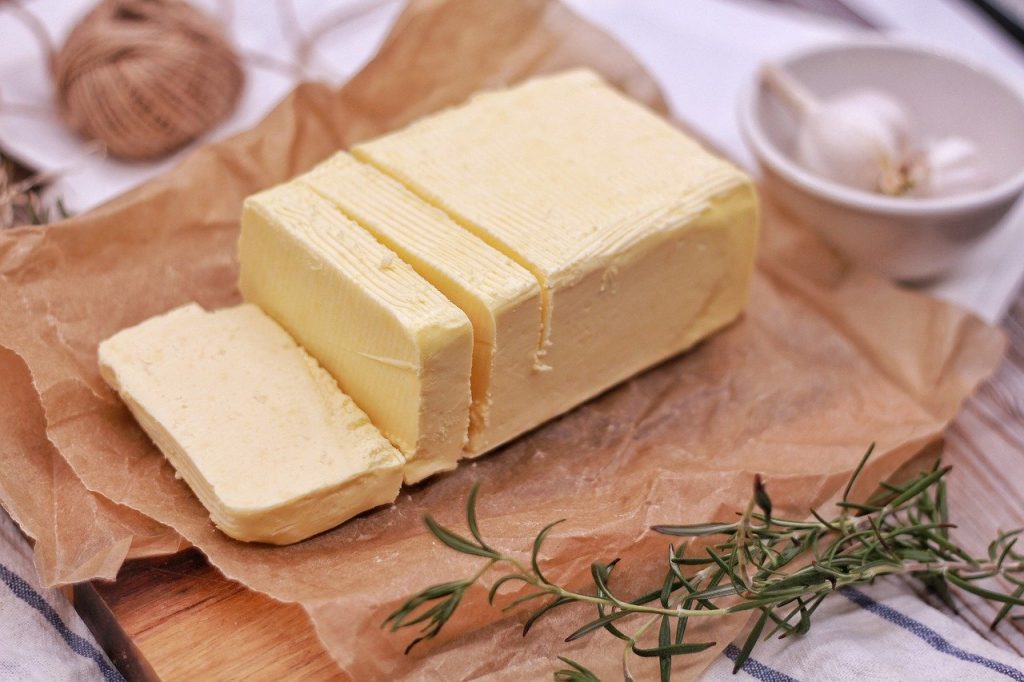[Article updated on 19/09/2023]
Lipids (or fats) should represent 30 to 35% of our daily nutritional intake. Butter, oil, margarine… Fats are everywhere on our plates. In addition to the taste pleasure they give us, fats provide energy to our body thanks to lipids that they contain. 1 gram of lipid = 9 kilocalories.
These lipids also play an essential role in the functioning of the membranes of our cells and our nervous system. So, you should not delete them!
However, certain fats, consumed in excess, contribute to an increase in cholesterol levels in our blood and should be limited!
It’s all about balance!
The different kinds of lipids (or fats)
There are fatty acids such as Omega 3, THE sterols like cholesterol and triglycerides which are the storage form of fats in adipose tissues. They come from meats, dairy products, sugars and even different vegetable oils.
Where are they found in food?
Fatty acids of animal origin are so-called saturated fatty acids. They are found in red meats, eggs and dairy products.
Fatty acids of plant origin are so-called unsaturated fatty acids. They are mainly found in oils such as rapeseed, olive oil or peanut oil but also in fish.

What are their roles ?
They represent the reserve energy that our body stores and uses only if our needs increase. Lipids provide us with:
- essential fatty acids: omega-3 (growth and brain development), 6 and 9 which our body does not know how to produce, they are found mainly in fats of plant origin. They play a role in the brain, skin, hair, transit… They are mainly found inColza oil which help lower bad cholesterol;
- vitamin A (in butter) which improves night vision and helps maintain the skin;
- vitamin E (in vegetable oils and margarines) which protects cells and limits cellular aging;
- saturated fatty acids from animal fats, on the contrary, risk promoting the appearance of cardiovascular diseases when they are in excess.
How to choose the right fats? Cooked or raw?
THE fat are essential to our body but we must know how to use them properly. Butter or margarine on our toast, oil in our salads, in our fried foods…
There are certain rules to follow to maintain the benefits and avoid the production of toxic compounds for our health.
Butter
Of animal origin, it should rather be used raw because its cooking point is quite low (120°C compared to 160°C for oil). Beyond this cooking point, the butter blackens very quickly and therefore becomes toxic. Choose unsalted butter (82% fat), it is the most natural because it is made only with milk cream!
Margarine: be careful!
For cooking or making toast, the margarine, of plant origin seems to be an interesting alternative. It supports cooking at high temperatures well. but beware, to make it solid, manufacturers use a process called hydrogenation which will have effects on health because of the classic industrial process which reveals molecules which did not exist in the original product which we call trans fatty acids and which increase cardiovascular diseases!
Alternative: make your own homemade margarine !
Vegetable oils
They are very good sources of lipids, and a very good fuel for our body, but not all of them have the same nutritional benefit.

Walnut oil: flavor above all!
Nutritional benefit: Rich in omega-3 (around 10%), omega-9 and vitamin E.
Its weak point: omega-6 (55%).
Cooking: use fresh because it is fragile and does not resist heat.
When cooked, its taste is distorted and its nutritional value reduced. Store in a cool place and away from light.
Use: in salads (mash, endives, etc.), as a seasoning for hot vegetables or vegetable purees, to flavor cake batters instead of butter (muffins, etc.).
Olive oil: ideal for cooking
Nutritional benefit: contains between 75 and 80% omega-9, lots of vitamin E and polyphenol which varies depending on climatic conditions and olive varieties.
Its weak point: low intake of omega-3.
Cooking: supports all cooking thanks to its richness in oleic acid (omega-9) which resists heat.
Use: ratatouilles, pizzas, raw vegetable salad, cooking and marinades of your meats, fish, etc.
Grapeseed oil
Nutritional benefit: Contains mainly omega-6 (70%), omega-9 (20%) and a little omega-3.
Rich in vitamin E.
Cooking: resists heat well and retains its flavor.
Use: the ideal flavored oil for preparing mayonnaises, marinades; Mixed with oleic sunflower oil, it is used for fondues…
Sunflower oil: versatile
Nutritional benefit: Very rich in vitamin E (1 tablespoon = half of our daily needs), in omega-9 (30%).
Its weak point: too rich in omega-6 (60%).
Cooking: Very heat stable (especially in its oleic form), in frying and cooking.
Use: neutral taste, sauces, seasoning, dishes, dessert (cake, pancake batter, etc.)
Rapeseed oil: balanced
Nutritional benefit: Rich in omega-3 (10%) and balanced in omega-3 and 6 (ratio 2.5).
Rich in vitamin E. Preferred in cases of osteoarthritis or inflammatory problems!
Cooking: gentle cooking (no more than 160°C).
Use: seasoning, salads, cooking simmered meats, fish, in casseroles, etc.
Sesame oil: fragrant
Nutritional benefit: Balanced in omega-9 and 6 fatty acids (40% each), rich in vitamin E.
Contains little omega-3.
Cooking: Should not be heated to high temperatures as it gives off an unpleasant odor.
Use: a slight grilled taste enhances Asian recipes, green salads, raw vegetables, etc. seafood, fish and meat marinades.
Linseed oil: concentrated omega-3
Nutritional benefit: richest in omega-3 (60%) therefore fragile and very oxidizable: must be stored in a cool place and protected from light. Avoid heating it and respect the expiration date.
Cooking: Cannot be cooked because it is too rich in omega-3.
Use: as a seasoning.
Peanut oil: resistant
Nutritional benefit: Rich in omega-9
Its weak points: too rich in omega-6 and little omega-3.
Very allergenic: avoid using it in children under 3 years old and during pregnancy.
Cooking: Very stable at high temperature, frying.
Use: frying, cooking meats.
In what quantity should we consume them to be and stay healthy?
For cooking, oil (olive or sunflower) is preferable to butter: 1/2 to 1 teaspoon per person.
If you pay attention to your figure, you must put at least at every meal the equivalence of:
- 1-2 tablespoon of vegetable oil,
- a knob of fresh butter on each toast in the morning or on vegetables or starchy foods after cooking
- i.e. 2 -3 tablespoons of crème fraîche 15-30% fat.
For salads, allow 1 teaspoon of oil per person + one for the salad bowl (olive, rapeseed, sunflower… vary!).
Fried foods (chips, fries, breaded foods): limit them to once a week maximum.
Cold meats and cheeses: Be careful, rich in saturated fatty acids and limit them!
- once or twice a week for cold cuts! Prefer white ham, gray meat and bacon which are leaner. !!! They contain a lot of salt which increases the risk of hypertension!
- 1 serving of cheese per day, to alternate with a natural dairy product (classic natural yogurt, petit suisse, semi-skimmed milk fromage blanc, etc.)!
Avoid low-fat dairy products, they lack taste and you will tend to consume more of them!
Taste pleasure is important because a diet that satisfies the palate allows you to reach satiety more quickly! So it’s good for your health and your figure!
In summary: Lipids are essential to our functioning but not in any form or quantity!
